I am really pleased to bring you this easy croissant recipe today. The dough is easy to work with, and the entire recipe only takes about 3-ish hours from start to finish. Traditional croissants, while incredibly delicious, take several days to make. I do encourage you to make true French croissants at least once if only to appreciate this shortcut method that tastes just as good.
I’ll show you how to build in your layers in just a few steps, how to shape the dough, and how to proof and bake. You’ll also learn some tips and tricks that will help you be successful with these fast croissants.
For ease of browsing, you can find all my bread and roll recipes in the same place. Thanks so much for being here. Let’s get started!
Pastry Chef Online Participates in Affiliate Programs. If you make a purchase through one of my links, I may earn a small commission. For more information click to read my disclosure policy

Easy Croissant, at a Glance
✔️Skill Level: Intermediate
✔️Skills: Laminating dough, Shaping, Proofing, Eggwashing
✔️Type: Laminated, Yeasted Pastry
✔️Number of Ingredients: 7
✔️Prep Time: 30 minutes
✔️Rise Time: about 2 hours
✔️Cook Time: 30 minutes
✔️Yield: 7 large croissants or about 15 minis
Related Recipes: All-Butter Angel Biscuits, Puff Pastry
Jump Straight to the Recipe
You Will Love This Recipe If
Not all recipes are for everyone, so take a look here to see if these easy croissants are something you’ll enjoy.
You’ll like these if you:
- love buttery baked goods
- appreciate a crisp, flaky crust and a soft interior
- are not interested in spending 3 days making something that will be gone in 3 seconds
- like a good shortcut but aren’t willing to sacrifice ingredient quality
If this checks all your boxes, read on to learn all the ins and outs, or jump straight to the recipe, read it thoroughly, and then get started!
When you do make this recipe, it will help me and other readers if you:
✅Rate the recipes using the stars in the recipe card
✅Leave a review when prompted in the recipe card (If it’s a positive review, and I hope it is, I’ll use it in the post as social proof)
✅Leave a comment on the post
Thank you so much!
Tasting Notes

Following the steps in this recipe will result in croissants that are:
- slightly sweet and yeasty
- very buttery
- crispy with flaky layers on the outside
- tender on the inside
Also, the full-sized croissants (as shown in the photos) are about 5″ long. They are not monster-sized like the soft and not-browned-enough croissants you find in the grocery store in the US.
How to Make Them
Even as a shortcut recipe, there are a fair number of steps to make this recipe.
None of them are difficult, and I’ll go through all of them with you.
If you’ve never made croissants, you’ll be able to confidently make these.
And if you have made them before, you’ll find this streamlined version much easier and quicker to make than traditional yeasted croissants.
Ingredients and Substitutions
Here’s what you’ll need to make this recipe:
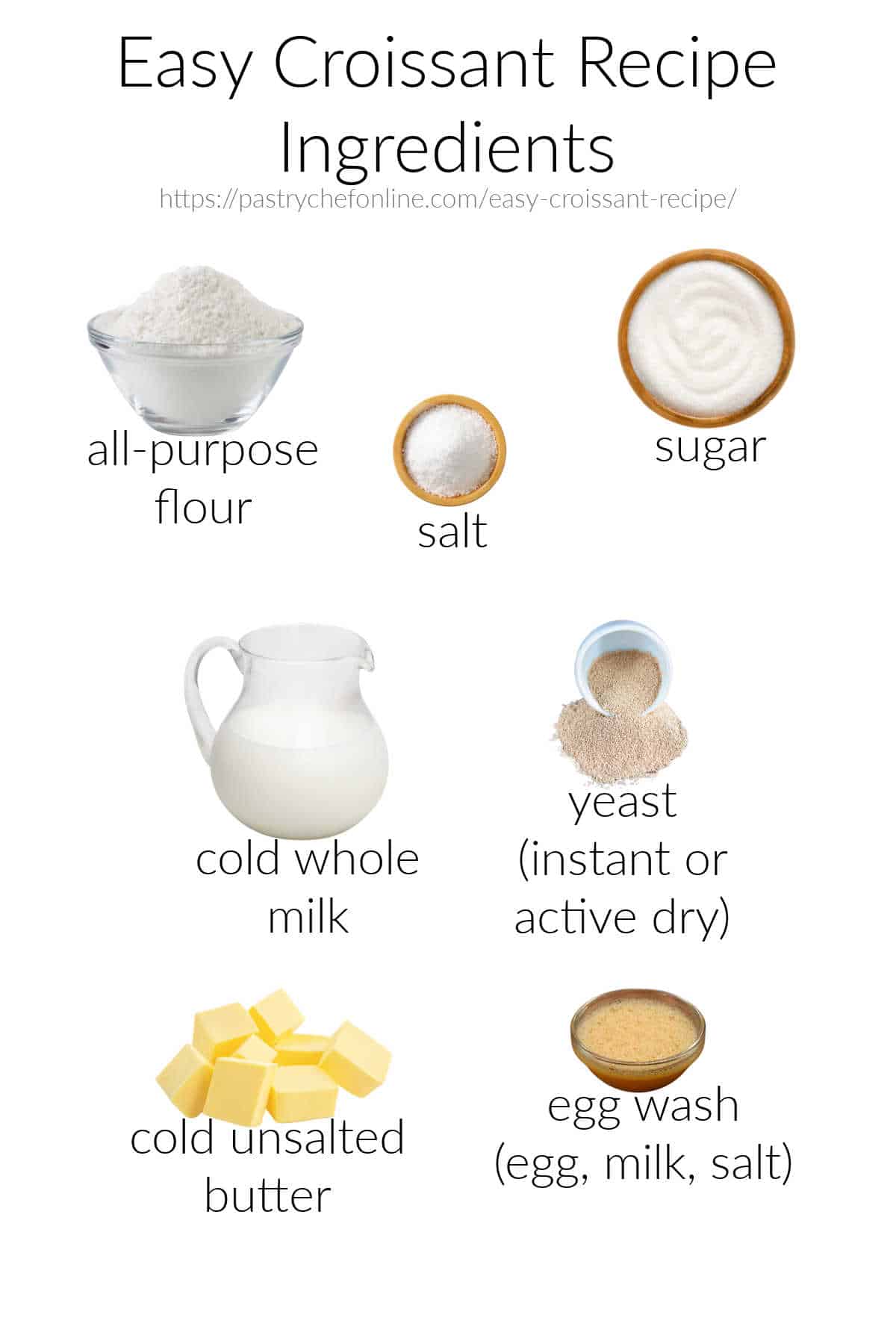
Procedure
First, make the dough. This is a pretty straightforward process.
If you’ve made puff pastry before, this procedure will be pretty familiar.
Here are the steps:
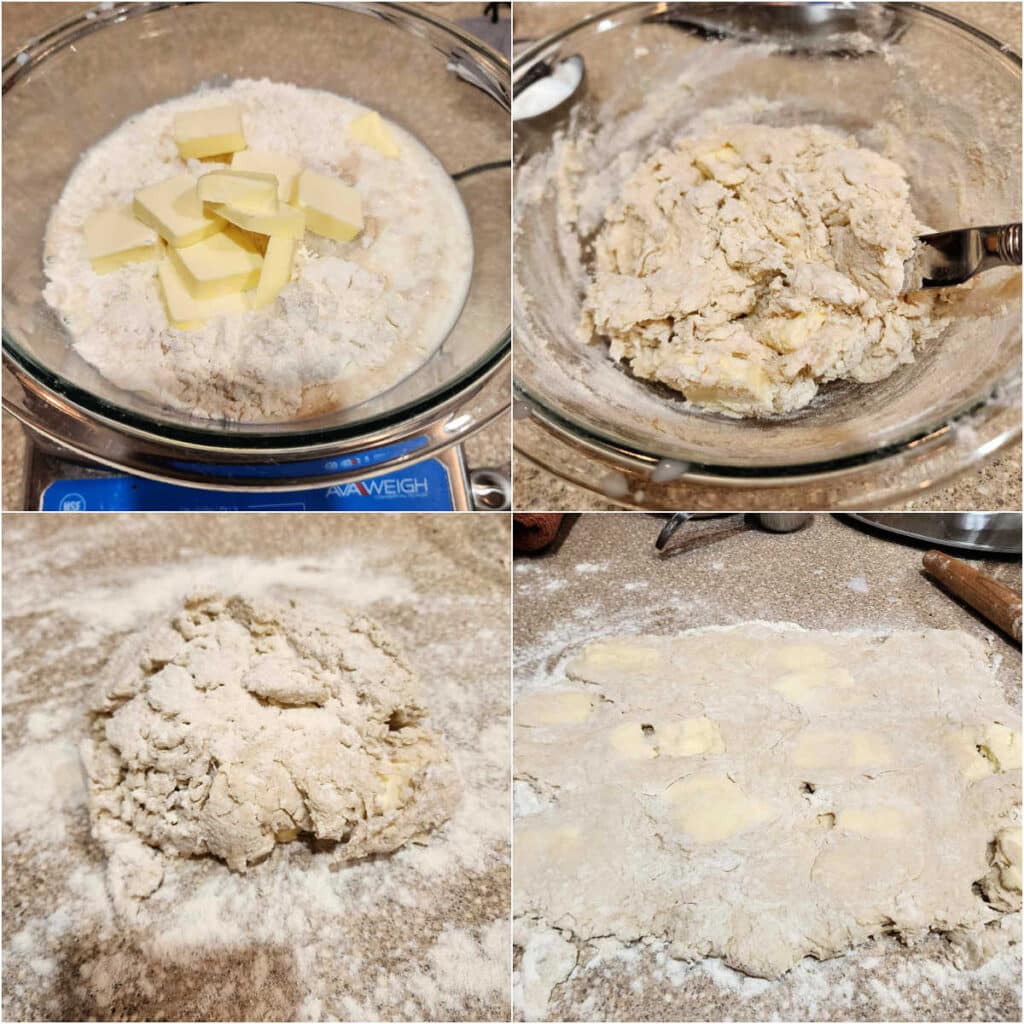
- Whisk all the dry ingredients together, including instant yeast. Pour in cold milk and butter in large chunks.
- Bring the dough together in the bowl gently. I used the blade of a dinner knife to stir.
- Dump out the dough on a lightly-floured counter and dust a bit more flour on top.
- Roll out into a messy rectangle filled with big chunks of butter. Press those chunks down with your rolling pin to start softening them up so they’ll roll into large sheets.
Now It’s Time for the Folds
Once you have your dough, it’s time to start building in the layers, and the way to do that is to roll the dough out, fold it, and roll it again. And again.
Here’s the rolling schedule I used for these croissants. The layers came together quickly and only required one 15-minute rest to let the gluten relax a little:
✅1 quarter fold (fold in half left to right and then again, top to bottom)
✅3 letter folds (rolling into a rectangle and then folding in thirds like a letter)
✅1 book fold (roll into a long rectangle, fold each end toward the center so they almost meet in the middle and then fold one half over the other like closing a book)
Here are some collages to illustrate the folds, shaping, egg washing, and rising.
The First Fold
I made a “quarter fold” for the first fold. This is not a traditional fold, but since these are nontraditional croissants, I’m not sorry, and it starts the dough out with more layers than a traditional letter fold (which we’ll do later).
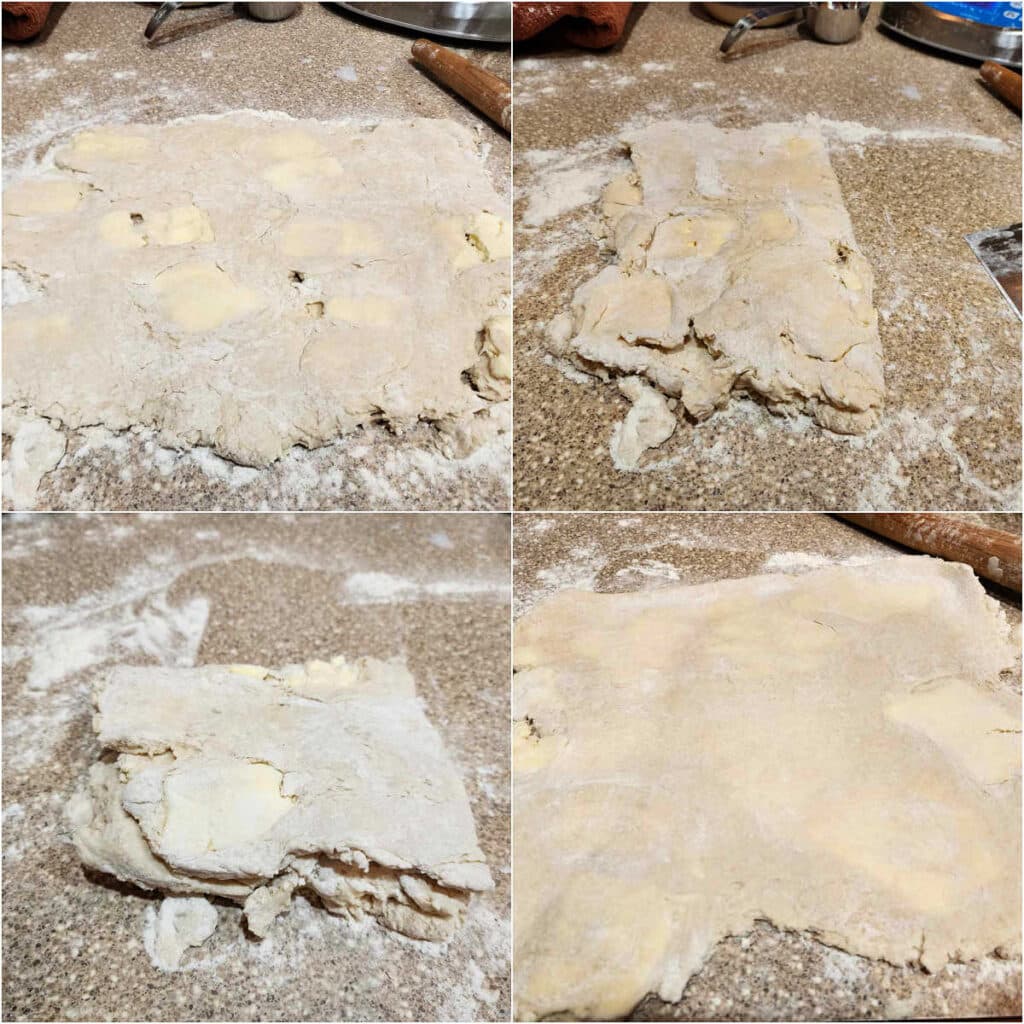
Folds 2, 3, and 4
If at any point the butter gets too soft and melty, wrap the dough up and put it in the fridge for about 30 minutes before continuing with your rolls and folds.
The next 3 folds are letter folds. That’s where you roll the dough out into a rectangle, fold one side in and the other side over just like you’d fold a letter:
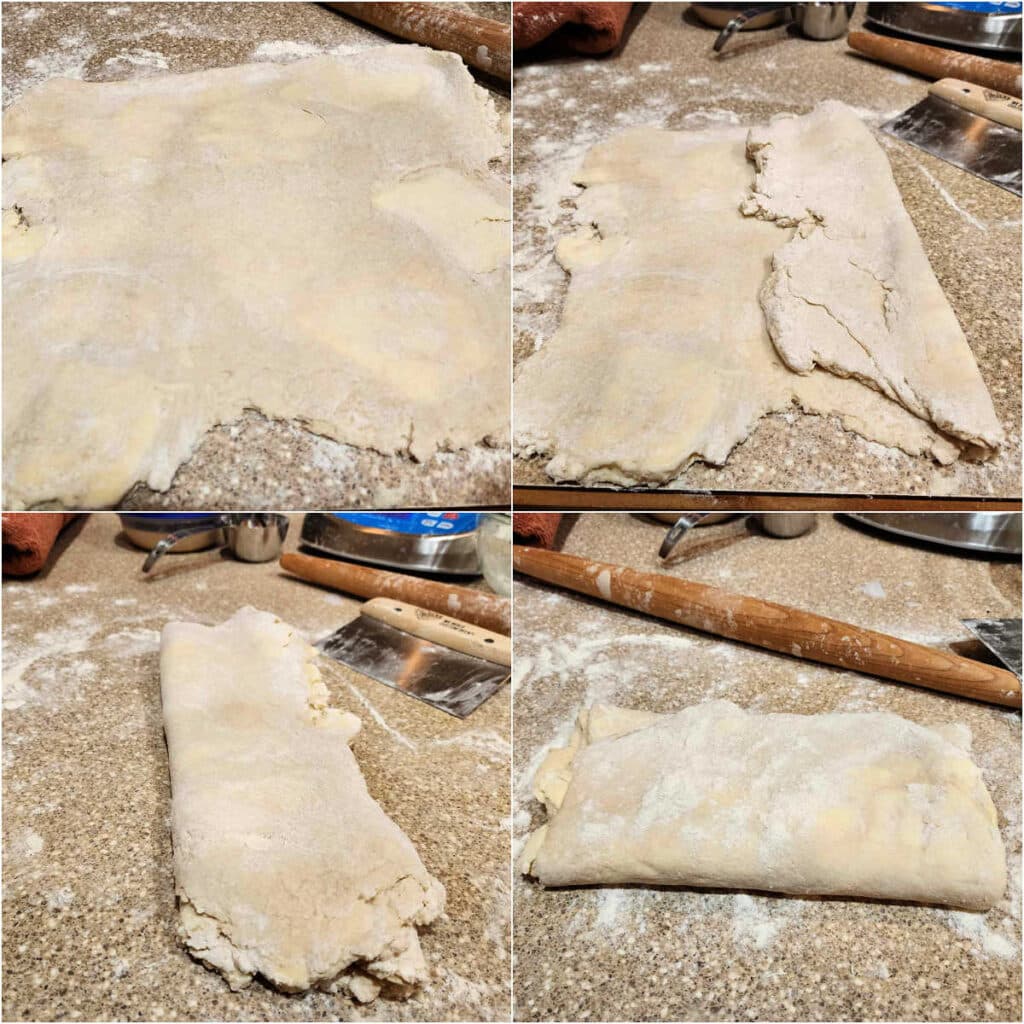
Then, rotate the dough 90 degrees and roll it out again, folding it like a letter and rotating it 90 degrees again.
Rotating the dough 90 degrees signals the end of a turn.
Note that each turn yields a smoother dough with thinner, larger layers of butter.
When making traditional croissants, it’s necessary to be precise in lining up the edges and corners of the dough so the dough will rise evenly and will have a consistent number of layers from end to end.
While not as vitally important when making this easy version, try to be more precise with each roll.
Pictured below is the third roll. Notice in the bottom left image that some butter is peeking out of the layers. That’s easily fixed by sprinkling some flour onto the buttery spots and rolling it in lightly.

One more like that, and there’s only one more fold left to do before rolling it to its final thickness, trimming it, and cutting it.
Do these 3 folds one after the other. If the butter in the dough gets too soft, refrigerate it for a bit.
And if the dough gets too hard to roll and starts bouncing back, cover the dough with plastic wrap and let it sit for about 20 minutes so the gluten has a chance to relax.
This happened once to me. If it happens more than once, it’s okay. The dough will tell you what it needs.
Jenni Says: Refrigerating will also give the gluten in the dough a chance to relax, so if you have to refrigerate your dough once or twice, that should be sufficient for you to get all your rolls and folds done without resting the dough. If you work fast though, you will probably need to let the dough rest at least once.
Fold 5
The last fold is a book fold.
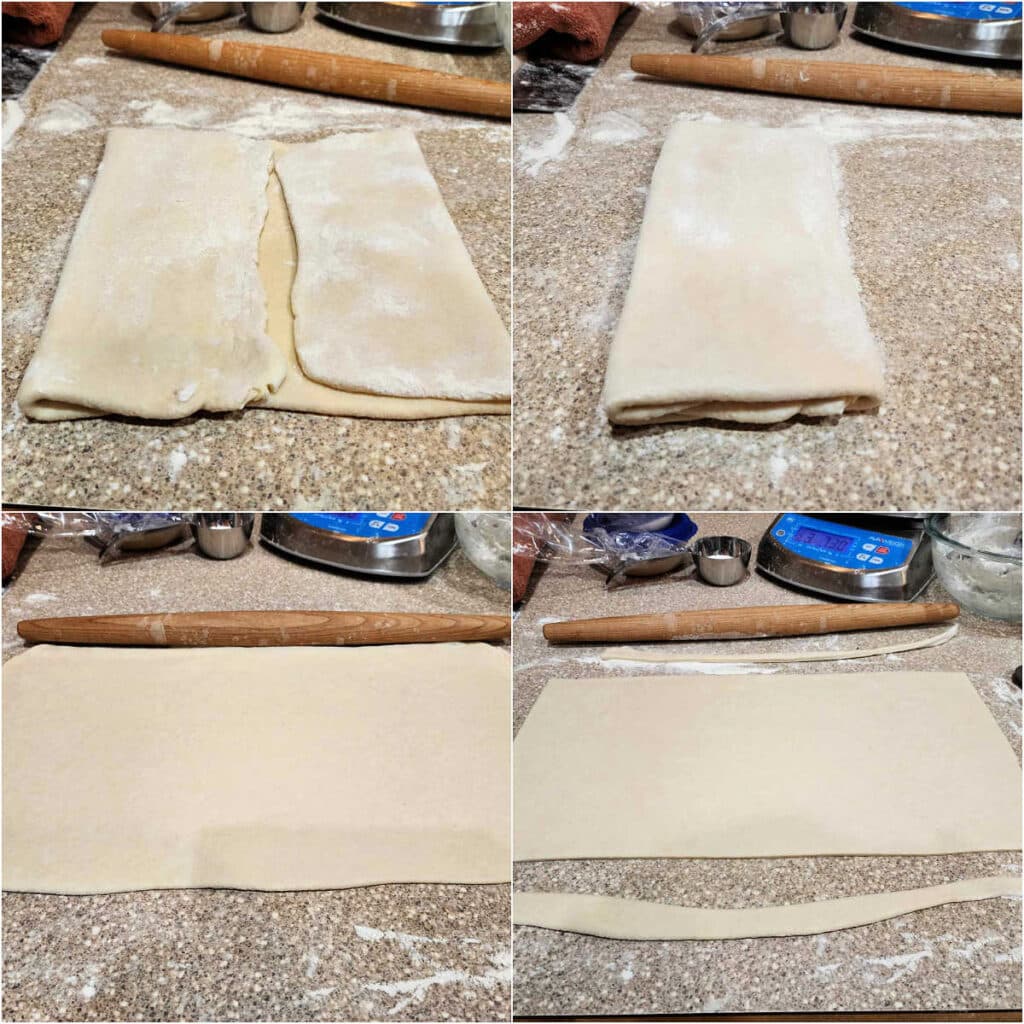
Roll the dough out so it’s in the shape of a wide, short rectangle. The dough should be roughly twice as long as it is tall.
Fold each end in towards the center so the two ends almost meet.
Then fold the two sides together the same way you’d close a book.
Rotate the dough 90 degrees, and that’s the end of the last fold you need to make. Tada!
The Final Roll and Trimming the Dough
After you complete that last fold, rotate the dough 90 degrees and then roll it out until it’s about 3/8″ (9-10 mm) thick.
Use a pizza wheel to cut off all the folded edges so your dough will rise evenly. Then it’s time to cut your croissants.
Shaping the Croissants
Once you have your final rectangle of dough, you can divide it in half horizontally to make small croissants, or you can leave it the way it is to make full-sized croissants.
Note, the large croissants will be from 5″-6″ long once you bake them. Littles will probably be about 3:-4″ long after baking.
I chose to make large croissants. Here’s how to cut and shape the dough:
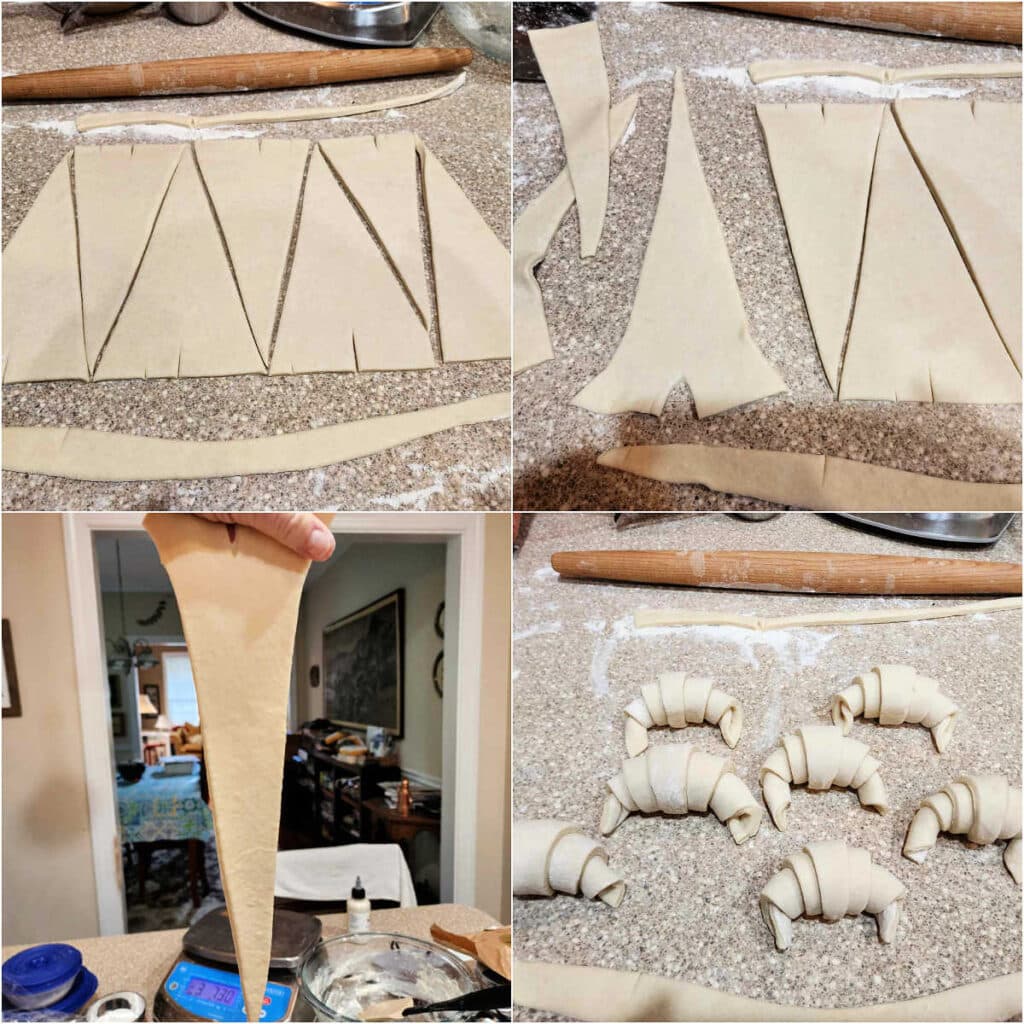
- Cut long, skinny triangles from your dough. Triangles should be about 3 1/2-4″ at the base with roughly 8″-9″ sides. Cut a small notch in the short end (base) of each triange.
- To shape the croissants, take each triangle and elongate it, either by a) rolling it gently with a rolling pin or b) holding it up by the base and gently stretching it toward the point.
- Then, pull the notch apart a little to help start the curve of the croissant,a nd roll it up, placing each croissant with the point underneath and then shaping it into a more prominent curve. You can also leave them “straight.” Your call.
Once shaped, place the croissants on a parchment-lined half-sheet pan with enough space between them to allow for the rise. You should be able to get all 7 croissants on the tray with no problem.
Egg Wash, Rise, and Bake
Make an egg wash with 1 whole egg, a tiny splash of milk or water (I used milk), and a pinch of salt.
Whisk it well.
Brush the croissants with a thin layer of egg wash, then place them in a warm-ish place to rise for 1 1/2 hours.
The ideal temperature for proofing is about 78F degrees. This is warm enough to make the yeast happy and to keep the butter soft but not so warm that the butter melts out of your croissants during the rise.
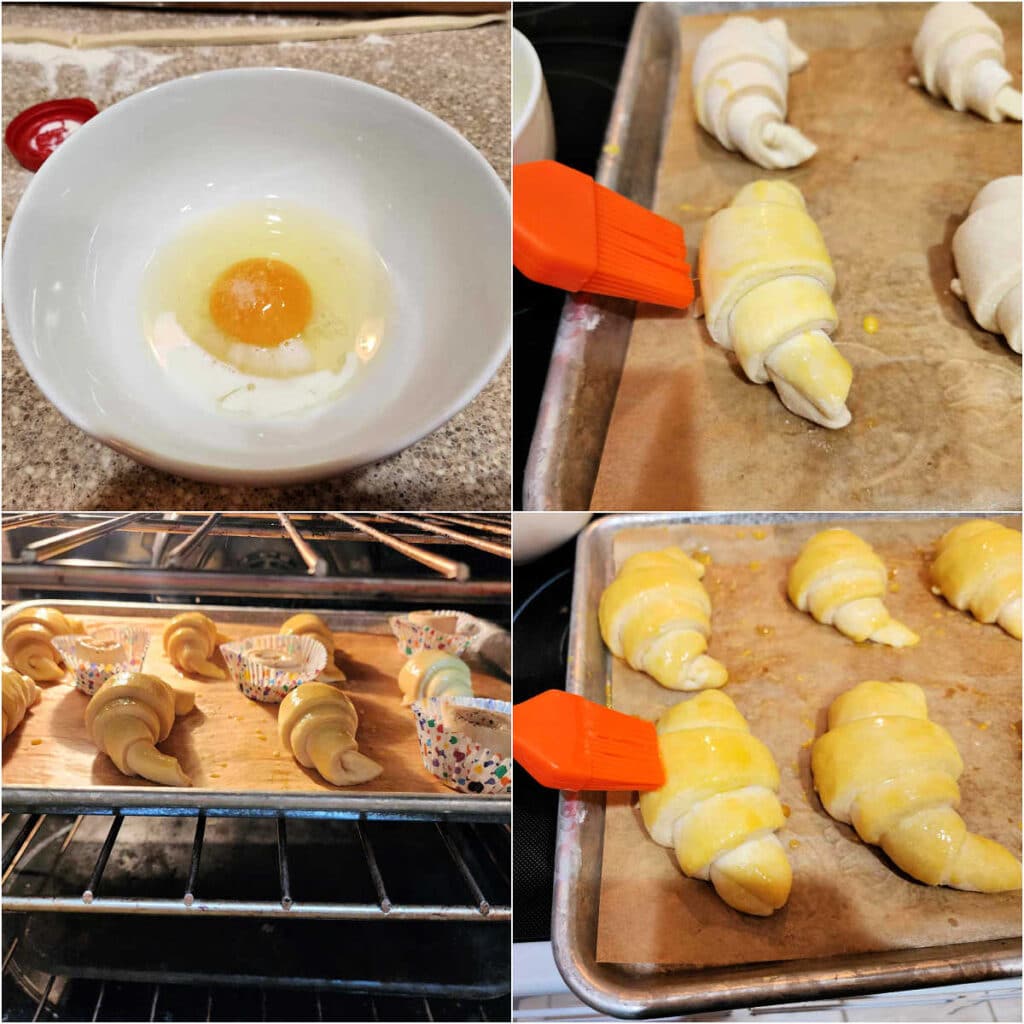
I preheat my oven for about 60 seconds and then turn it off, making sure the temp is no higher than 78F before putting my tray of croissants in to rise.
After about 90 minutes of rise, which should be pretty impressive, brush another thin coat of egg wash onto the croissants and leave them on the counter while you preheat your oven to 425F.
Once the oven reaches temperature, bake the croissants on the center rack for 10 minutes.
Then turn the heat down to 350F and bake until deeply golden brown, about 15-17 additional minutes.
Allow the croissants to cool for at least 20 minutes before serving–30 minutes is better, but I understand!

What to Do with the Edges You Cut Off
Do you see the little cupcake liners on the tray with the croissants?
Those were the ends I cut off. I just rolled them up like cinnamon rolls, plopped them in the cups, sprayed them with duck fat spray, sprinkled them with salt and pepper, and let them rise right along with the croissants.
Then I plopped the liners into a cupcake tin for baking.
These little savory guys were flaky and buttery, and absolutely delicious, so that is a great option for using the ends.
You can also roll them in cheese and/or herbs, and twist them just like you would if making cheese straws.
Variations
To make whole wheat croissants, substitute up to 50% of the flour with the same amount of whole wheat flour.
To make easy medialuna or Argentinian croissants, double the sugar and proceed as written.
Make cinnamon croissants by adding 1 Tablespoon of cinnamon to the dry ingredients.
Experiment with using extracts such as vanilla or almond in the milk or adding citrus zest.
To make an easy pain au chocolat, cut the dough into small rectangles and fold chocolate batons inside like this. (The batons are made from seized chocolate, so while they melt, they don’t spread and run all over the place like a chocolate bar would. You could also substitute dark chocolate chips which also hold their shape.)
Use this same rectangle shape to make ham & cheese croissants or any other type of stuffed croissant you can think of. Use a maximum of about 3 Tablespoons of filling and be sure not to overfill lest your guys get soggy or burst open.
Equipment You May Need
For a specialty pastry, you really don’t need a lot of special equipment.
If you work very precisely, you’ll want to use a ruler as both a straight edge and to measure for equal-sized croissants.
You’ll need a bench knife to help you do the initial folds when the dough is still very shaggy.
Cut the croissants with a pizza cutter.
You could spring for a fancy croissant cutter, but honestly, they take up a lot of room, you’ll rarely use it, and they are easily knocked out of shape.
Lining your half-sheet pan with a parchment sheet makes for easy cleanup and no sticking.
I use this kind of parchment sheet:
- Cut to fit perfectly in a half-sheet pan
- Can be cut into circles if necessary
- No need to cut for different-sized rectangles. Just fold to fit.
Tips and Tricks for Success
Even though there are a lot of steps to making this recipe, most are very easy and involve a lot of repetition.
I encourage you to work fairly quickly and don’t worry too-too much about how evenly you roll out dough.
The goal of an easy croissant recipe is just that: ease.
So have fun with it, and if you need to stop for a bit for any reason: if your butter is getting too soft or the dough is resisting being rolled, just refrigerate it for 20-30 minutes and then keep going.
Serving Suggestions

Serve your croissants for a fancy continental breakfast with some salted butter and mixed berry jam.
Or make breakfast sandwiches with fried or scrambled eggs with cheese and bacon jam or onion jam.
Serve them for brunch or lunch with some curried chicken salad (pictured), because chicken salad on a croissant is Peak Fancy!
Croissant Q & A
These guys are best eaten the day they’re made, but they’ll be fine for 24 hours (cover after cooling completely). If you need to keep them longer, go ahead and freeze them in zip-top freezer bags, pressing out as much air as possible before freezing. They’ll be fine for up to 2 months.
Use them to make French toast or bread pudding. You’ll probably like either of these options so much you may let your next batch get stale on purpose!
Other Laminated Dough Recipes
If you are a fan of layered baked goods, try my flaky cheddar biscuits or traditional puff pastry which you can use to make apple turnovers, pot pies, or other tasty, flaky treats.
I even like to roll a few layers into my pate brisee for making pies. I find it makes a sturdier crust that’s less likely to crack and leak. Give that a try sometime.
Questions?
If you have any questions about this post or recipe, I am happy to help.
Simply leave a comment here and I will get back to you soon. I also invite you to ask question in my Facebook group, Fearless Kitchen Fun.
If your question is more pressing, please feel free to email me. I should be back in touch ASAP, as long as I’m not asleep.
A Note About Measurements
Don't let its small price and small size fool you. The Escali Primo is an accurate and easy-to-use food scale that I have used for years. It's easy to store, easy to use, has a tare function, and easily switches between grams and ounces/pounds for accurate measurements.
Love This? Please Share It and Review It!
It will help me and other readers so much if you take a moment to rate and leave a review for this recipe.
You can use the stars to rate 1-5 (5 is best), and leave a review in the comments. It helps me make adjustments if any are needed, and comments help others decide whether the recipe is worth making.
Other ways to share include pinning, and/or sharing on your favorite social media platform.
Thank you so much for taking the time!


Easy Croissant Recipe
Would you like to save this post?
Ingredients
- 354 grams all-purpose flour 12.5 oz or about 3 cups measured by whisking, spooning, and sweeping
- 19 grams granulated sugar .75 oz or 4 1/2 teaspoons
- 1 ½ teaspoons salt (I use Mortons) 9 grams or 0.3 oz
- 255 grams whole milk, cold from the fridge 9 oz or 1 cup plus 2 Tablespoons
- 2 ½ teaspoons instant yeast 7.75 grams or 0.3 oz
- 128 grams unsalted butter, cold from the fridge 4.5 oz or 1 stick and 1 Tablespoon
For the Eggwash
- 1 egg
- 2 teaspoons milk
- pinch of salt
Instructions
To Make The Dough
- If using active dry yeast rather than instant yeast, whisk it into a portion of the milk and let proof until bubbly, about 10 minutes. Otherwise, in a large bowl, whisk the instant yeast together with the flour, salt, and sugar.
- Pour in the milk (or milk plus the yeast/milk mixture).
- Cut the butter roughly into 5-6 chunks and toss that into the center of the bowl of ingredients.
- Use a the blade of a knife or the handle of a wooden spoon to gently but thoroughly mix the dough together so almost all of the flour is incorporated.
- Lightly flour the counter, scrape the dough out into a pile, and sprinkle a bit more flour over the dough.
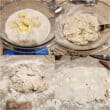
Rolls and Folds
- Roll out the dough into a rough square shape about 10"-12" on a side, using the rolling pin to press down on the large pieces of butter to start flattening them.
- Use your bench knife to fold the dough in half from left to right and then into quarters from top to bottom.
- Turn the packet of messy dough 90 degrees and roll out into a square about 10"-12" in diameter.
- Fold that square into thirds like a letter, rotate the dough 90 degrees, and roll into another square of the same size.
- Repeat twice more for a total of 3 letter folds. Rest the dough in the fridge for 20-30 minutes if the butter is getting to soft or the dough resists rolling out. Always end your turn by rotating the dough 90 degrees.
- Roll the dough into a long rectangle roughly twice as long as it is wide.
- Fold each end in toward the center and then fold those two halves closed like a book.
- Rotate the dough 90 degrees and roll out into a rectangle about 3/8" thick and roughly 20" wide by 12" long. Do NOT get too hung up on the length. We're making easy croissants, so relax. 🙂
Cutting and Shaping the Croissants
- Trim off all the uneven edges to leave you with a rectangle of dough about 18" wide and 9" long.
- Cut into long skinny triangles about 4-5" at the base. You will end up with 2 "half croissants," one on either end. You can roll those like regular croissants or treat them as scraps. I ended up with 7 croissants.
- Cut a 1" notch into the base of each triangle.
- One at a time, either gently roll each triangle into a longer, thinner triangle or hold the triangle up and gently run your hand down the length of the dough to gently stretch it both longer and thinner.
- Pull the notch apart a little. This will allow you to more easily curve the croissants.
- Starting from the base, roll the triangle up to the tip. Use your hands to curve the croissant as desired–some people like to bring the two ends around to meet in front to make more of a round croissant bun. Your call.
Egg Wash and Rise
- Place each croissant on a parchment-lined half-sheet pan with the point underneath to keep it from unraveling.
- Whisk the eggwash ingredients together and brush each croissant with a thin layer.
- Let the croissants rise at around 78F for 90 minutes.
- After 90 minutes, the croissants should have risen pretty impressively. If not, let them go for another 30 minutes.
- Then preheat the oven to 425F with a rack in the center. Brush the croissants with another thin layer of egg wash.
Baking the Croissants
- When the oven reaches temperature, bake the croissants for 10 minutes.
- Then turn the oven down to 350F, rotate the pan to promote even baking, and bake an additional 15-17 minutes until deeply golden brown.
- Remove from oven and allow to cool a good 20-30 minutes before serving.
Did You Make Any Changes?
Notes
Storing
Croissants are best eaten the day you make them but will be just fine the next day. Allow leftovers to cool completely and store in an airtight container on the counter. If you need to keep them longer, freeze them in zip-top freezer bags for up to 2 months.Doubling the Batch
You can successfully double the recipe to make 14-15 croissants. After you make the dough, cut it in half, cover and refrigerate one half, and work with the other half so the dough doesn't become unwieldy. Roll, fold, and shape the second half of the dough while the first batch is proofing.Nutrition
And that’s it, friends. I really hope you love the croissants.
If you make them, let me know how you eat them. For breakfast? Lunch? Picnic? Just for fun?
Thanks for being here. Take care, and have a lovely day.

Hi, y’all! I hope you’ve enjoyed this post and hopefully also learned a thing or two.
If you like my style, I invite you to sign up for my occasional newsletter, The Inbox Pastry Chef.
Expect updates on new and tasty recipes as well as a bit of behind-the-scenes action. I hope to see you there!
Would you like to save this post?



Join in Today!



First time ever trying croissants and I am very happy with the results. Followed the recipe, even baked the scraps in muffin papers.
The hardest part of the recipe was following the part that said to cool before eating. So delicious
Yay, Carlin! I’m so glad you love them!
I trust this website, her recipes are very tasty and her instructions are great!
Wow, thank you so much, Athena!